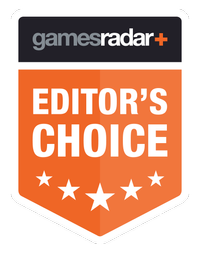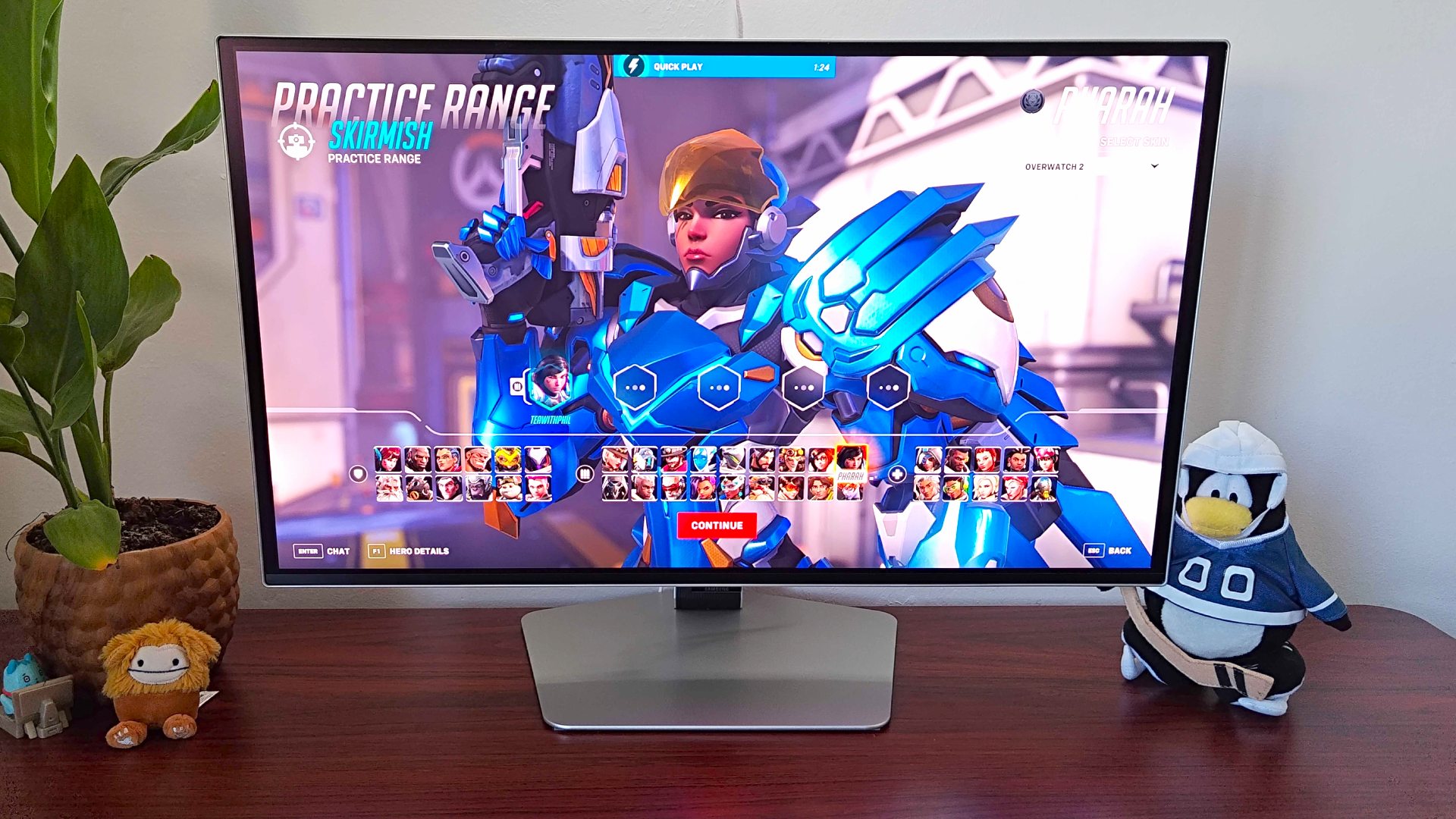GamesRadar+ Verdict
The Samsung Odyssey OLED G6 is a great example of a gaming monitor that can achieve super-fast speeds while still offering up glorious colors and contrast. Qualities like its anti-glare coating and striking aesthetic help it stand tall among other 1440p rivals, and it sets the QHD monitor bar to lofty new heights thanks to its balanced specs.
Pros
- +
Exceptional colors
- +
Excellent HDR
- +
Responsive 360Hz abilities
- +
Stunning design
Cons
- -
No USB-C hub
Why you can trust GamesRadar+
I didn’t originally have the Samsung Odyssey OLED G6 down as one of my favorite gaming monitors of the year, as I figured the accolade would go to a 4K screen. Now that I’ve spent a chunk of time with the new 1440p 360Hz screen, I can say without a doubt that I’m a silly billy, as this display strikes a tremendous balance between speed, sensational visuals, and sleek aesthetics.
Don’t get me wrong, I can’t promise the Samsung Odyssey OLED G6 won’t be stripped of its best gaming monitor title over the next few months, as the screen scene is fast-moving. However, I can guarantee that even if fierce rivals come for its crown, this new OLED screen will serve fantastic results for PC players, console lovers, and even retro enthusiasts alike. Plus, I love the idea of picking up a panel for your PS5 that could serve as a fast refresh rate display for FPS games if you go down that path at a later date.
There are admittedly a few things missing from the OLED G6 that I’d have loved to see included, but it’s important to remember this $799 / £799 display isn’t Samsung’s flagship. Therefore, I can understand why some more premium perks have been omitted, and I’m still pretty content with the overall package for the price. Yes, the KTC G27P6 does bite its ankles a little thanks to its budget-friendly price point, but this screen isn’t as comparable compared to the Corsair Xeneon 27QHD240 and expensive alternatives.
Specs
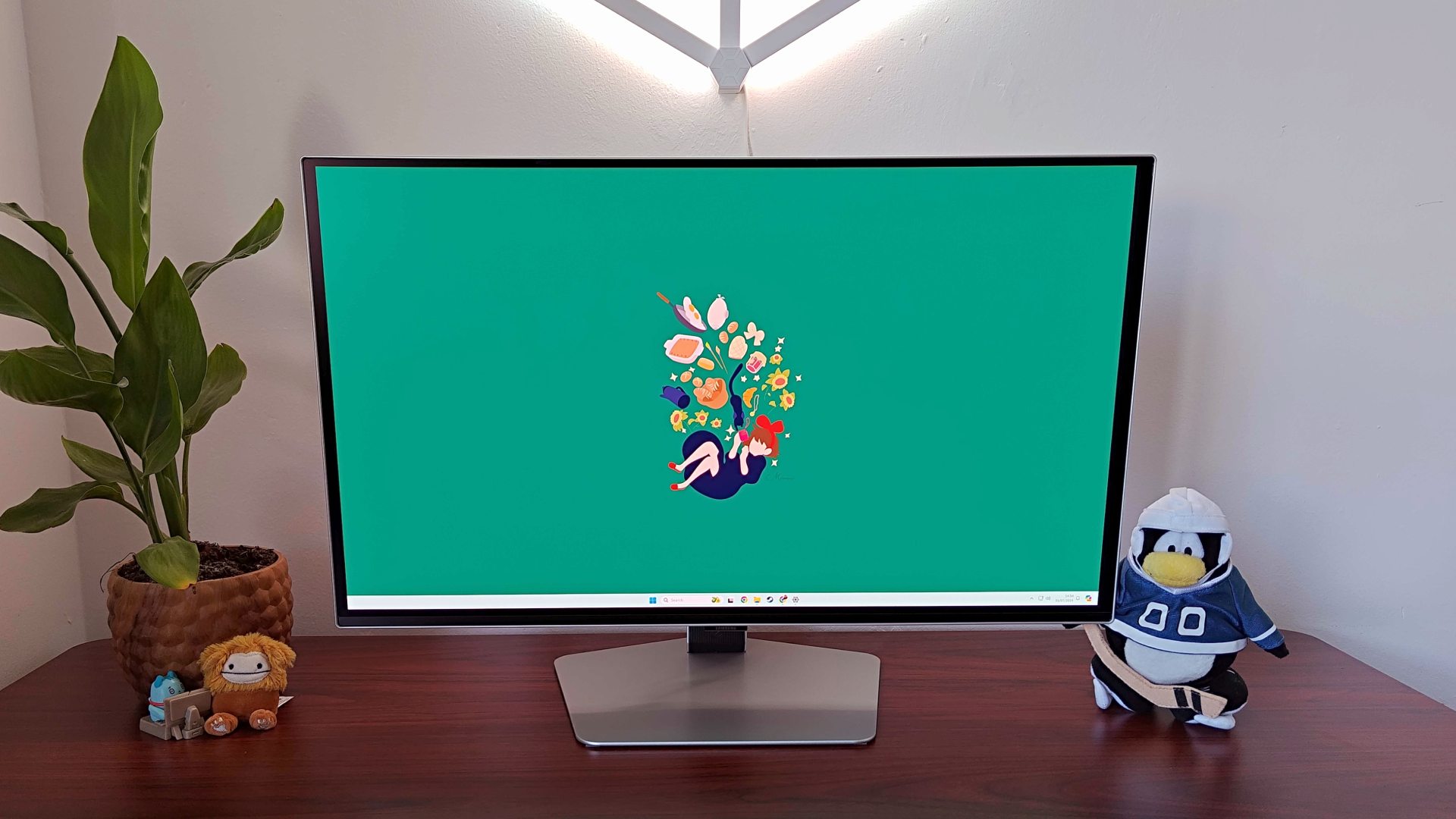
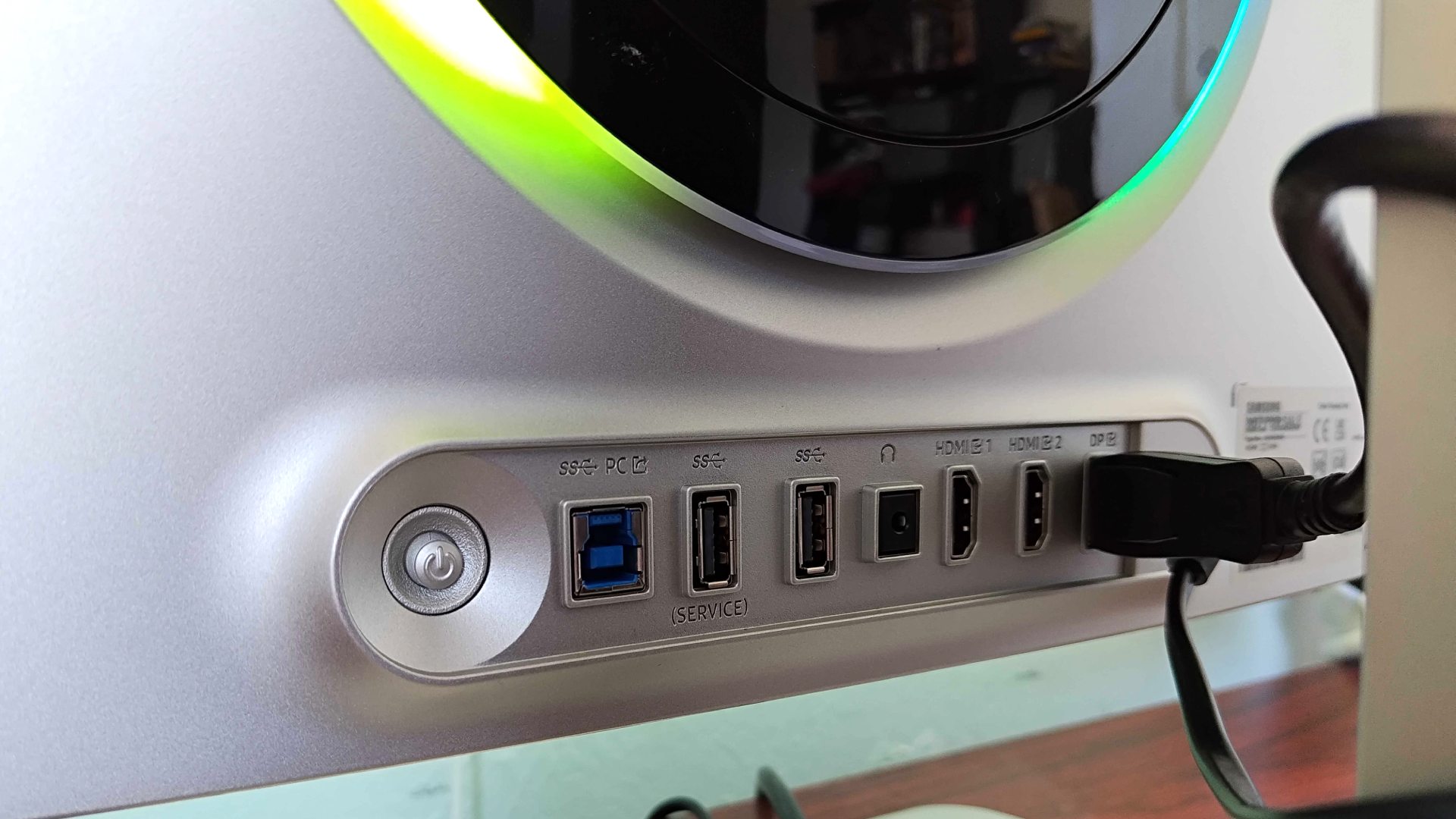
I’ve already spoiled the Odyssey OLED G6’s key screen specs, as we’re looking at a 27-inch 1440p 360Hz display. Other ingredients include a 0.03 GtG response time and HDR 10 alongside other expected traits like a 1,000,000:1 contrast ratio and 250 nits peak brightness.
| Specs | Samsung Odyssey OLED G6 (G60SD) |
|---|---|
| Price | $899.99 / £799 |
| Panel type | OLED |
| Screen size | 27-inch |
| Aspect ratio | 16:9 |
| Resolution | 2560 x 1440 |
| Refresh rate | 360Hz |
| Brightness | 300 nits |
| Viewing angles | 178°/178° |
| Contrast ratio | 1,000,000:1 |
As for ports, the OLED G6 keeps things fairly standard with two HDMI 2.1 ports, one DisplayPort, and two full-sized USB connections linked to a standard hub. I am slightly bummed out that this screen doesn’t boast Steam Deck dock capabilities via USB-C, but I’ve come to terms with that not being a huge deal since you can pick up a docking station for your gaming handheld fairly cheaply.
Design

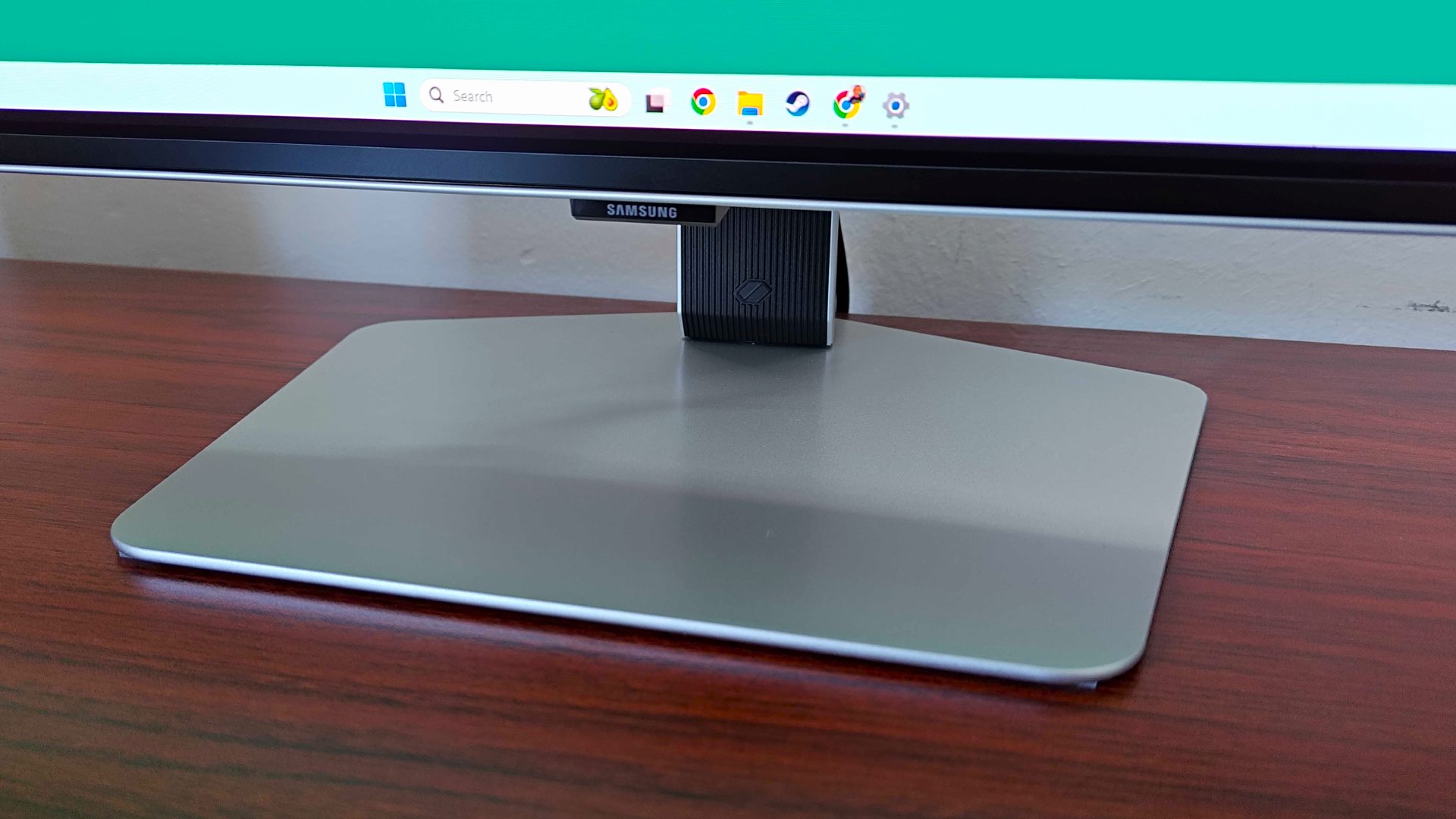
Please forgive me, as I’m about to gush over Samsung’s whole aesthetic approach with the Odyssey OLED G6. I’ll forgive any of you who can’t see what’s so special, but my feelings come from a heart that’s dealt with numerous screens over the past few years.
First off, I’m in love with the OLED G6’s flat hexagonal base. I was somewhat surprised by this, as I usually hate weird pedestal designs taking up needless space, but the low-profile design featured here provides somewhere to sit soundbars or even just other desktop bits (like whatever plushie has won my favor in a week). Its silver finish also makes for a nice change from the usual black getup screens tend to go with – something that’ll please those of you maintaining a brighter setup.
Before we head around the back, I need to highlight the OLED G6’s pivot and height adjustment abilities. It doesn’t perform any tricks not found with other rivals, but I immediately noticed a difference in how easy it is to move around. Too many displays feel needlessly stiff, which ultimately puts me off switching things vertically for some cheeky TATE arcade game sessions.
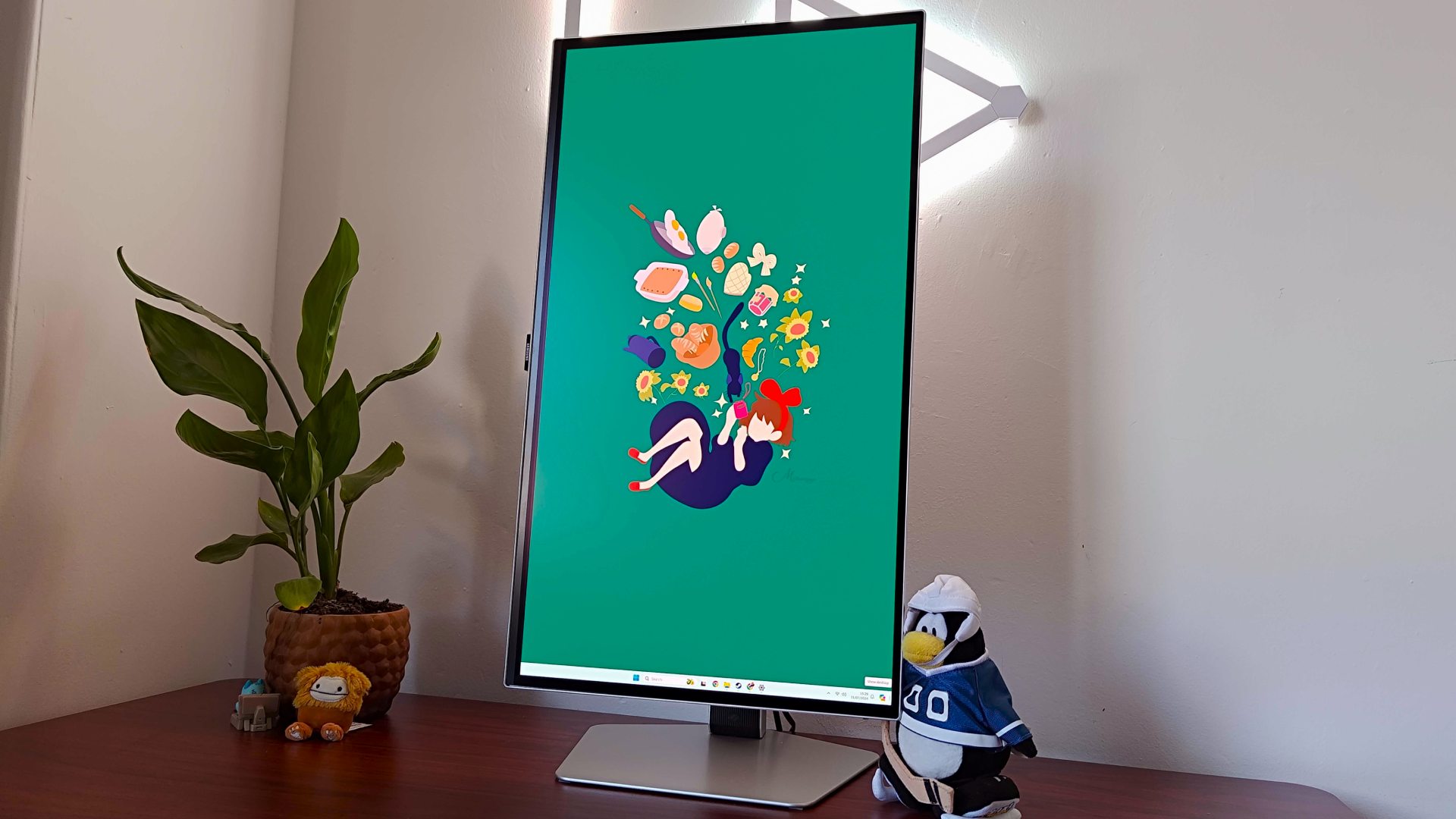
I also want to point out that the OLED G6 suffers from that same extra black masking border around its bezel, which always leaves me longing for a proper edge-to-edge screen. It’s not something I can justify marking Samsung’s display down for, as I’ve yet to find one that avoids committing this sin. Any company that wants to impress me in 2025 will somehow come up with a way to completely eradicate borders to the same degree as a gaming phone, as it’s the one thing that keeps catching my eye with modern monitors.
The rear of the G6 is an absolute treat on numerous levels, not least due to the refined vortex RGB light ring at the back. The back panel is notably slimmer than previous Odyssey models, despite the fact that there’s a dynamic heat pump cooling system stowed away underneath. The illuminated ring also feels subtle enough to appeal to those who are averse to rainbow lighting, with elegant tapering factoring it into the overall design without its presence feeling too obvious.
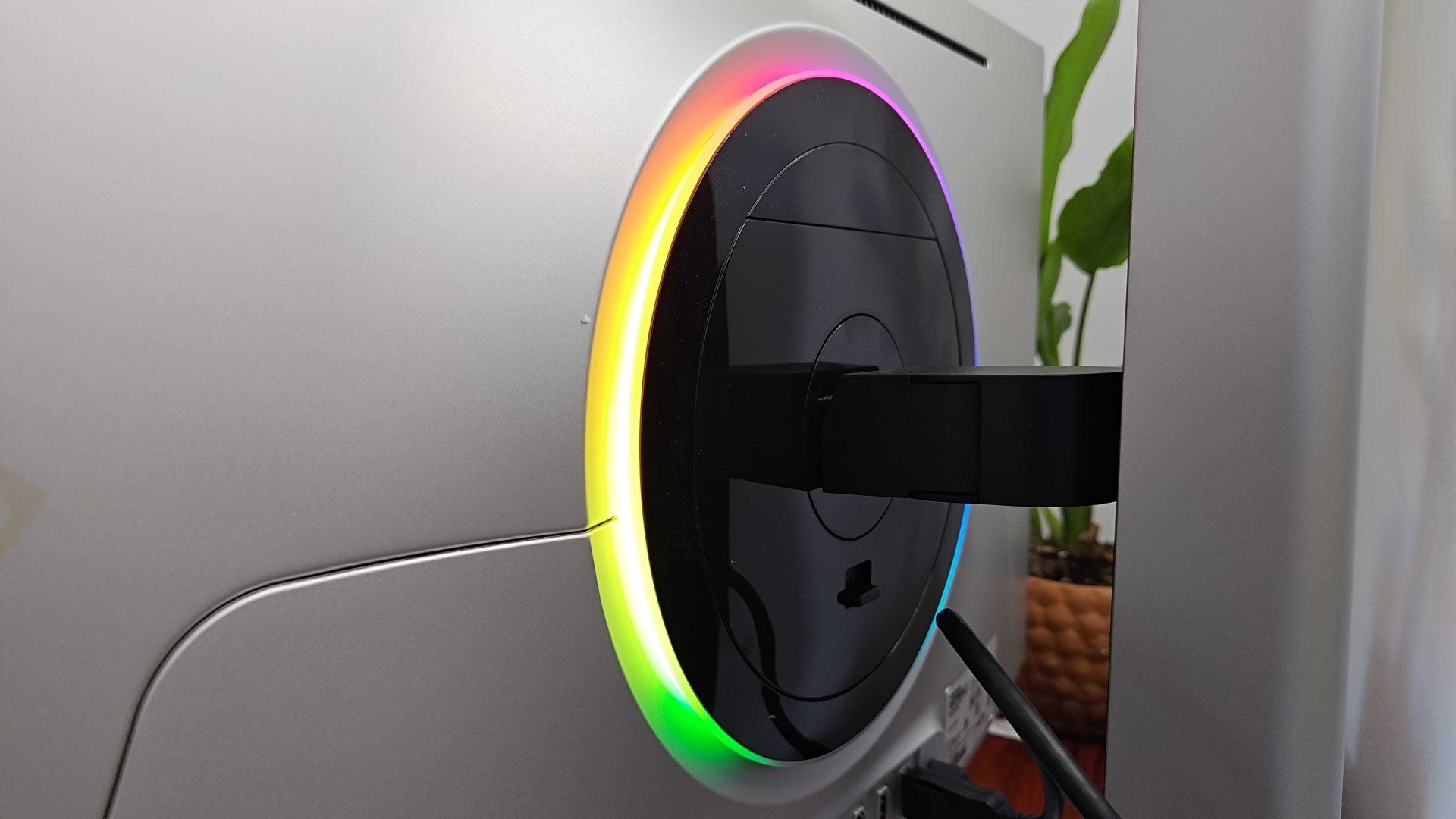
I’ve said this many times, but I much prefer ports that face outwards instead of under a lip, and Samsung has nailed this sentiment with its setup. You’ll still be able to easily manage cables using the pedestal and clips, but it negates any fumbling around when trying to hook up another console or PC. Trust me, this is a wonderful boon if you find yourself constantly switching out your PS5 and rig for another device on the fly.
Next to the ports is the dreaded OSD menu nub – a mainstay of gaming monitors today. Funnily enough, the first time I used one of these dastardly wee joysticks was with a 2010s Samsung TV, so I do subconsciously blame the company for its standardization. Despite this, the control nipple is actually one of the less offensive versions I’ve used lately, with each direction feeling precise. It probably helps that the settings menu itself is streamlined, as you won’t have to dive three pages deep into options to reach simple dials.
Let it be known that I’m holding back on my usual “all monitors should come with a remote” rant since Samsung does include one with the Odyssey OLED G8. Am I still annoyed? Yes, but I get why the company would position the perk as a premium extra.
Features

While I wouldn’t exactly call the Odyssey OLED G6 feature-packed, the screen does offer excellent tricks to benefit its overall viewing experience. One of the most prevalent talking points about this monitor is its anti-glare coating, which bats away reflections far better than any screen I’ve tried to date. My office is pretty glary, to say the least, and the only real way for me to avoid the usual light beams is to close my blinds. At least, that was the case before using the G6, as I’ve yet to find an angle that succumbs to my big window.
As for settings dwelling within the G6, some key elements stand out within the OSD. The first thing that caught my eye was the Infinity Core sub-menu containing a bunch of customization options for the RGB ring round back. It’s always pleasing to see these dials accessible from the monitor itself rather than via a separate piece of software, and you can even set the lighting to color-match whatever’s on your screen. It’s not quite as impressive as the Ambiglow system built into the Philips Evnia 42M2N8900 as it seems to only do static colors, but I’m all for neat extras where I can find them.
Speaking of which, the G6 also provides the usual array of gaming quirks within its OSD, including virtual crosshairs and adaptive sync settings. Objectively speaking, it’s more important to have OLED screen care options to hand than any of those, and I’m pleased to report there’s a logo brightness and pixel refresh mode within general settings. If you’re more worried about your peepers than potential panel burn-in, you’ll be able to access eye-care settings by pushing left, in turn providing filters that ditch blue light to varying degrees.
I’ll round off my thoughts on features by touching on the Odyssey OLED G6’s no-thrills USB hub. It’s effectively just a way to hook up a gaming keyboard and mouse to your PC via a single cable, so nothing earth-shattering in terms of handheld and laptop support. I’m still glad it's a thing, don’t get me wrong, but I do enjoy directly hooking my Steam Deck OLED to screens these days.
Performance
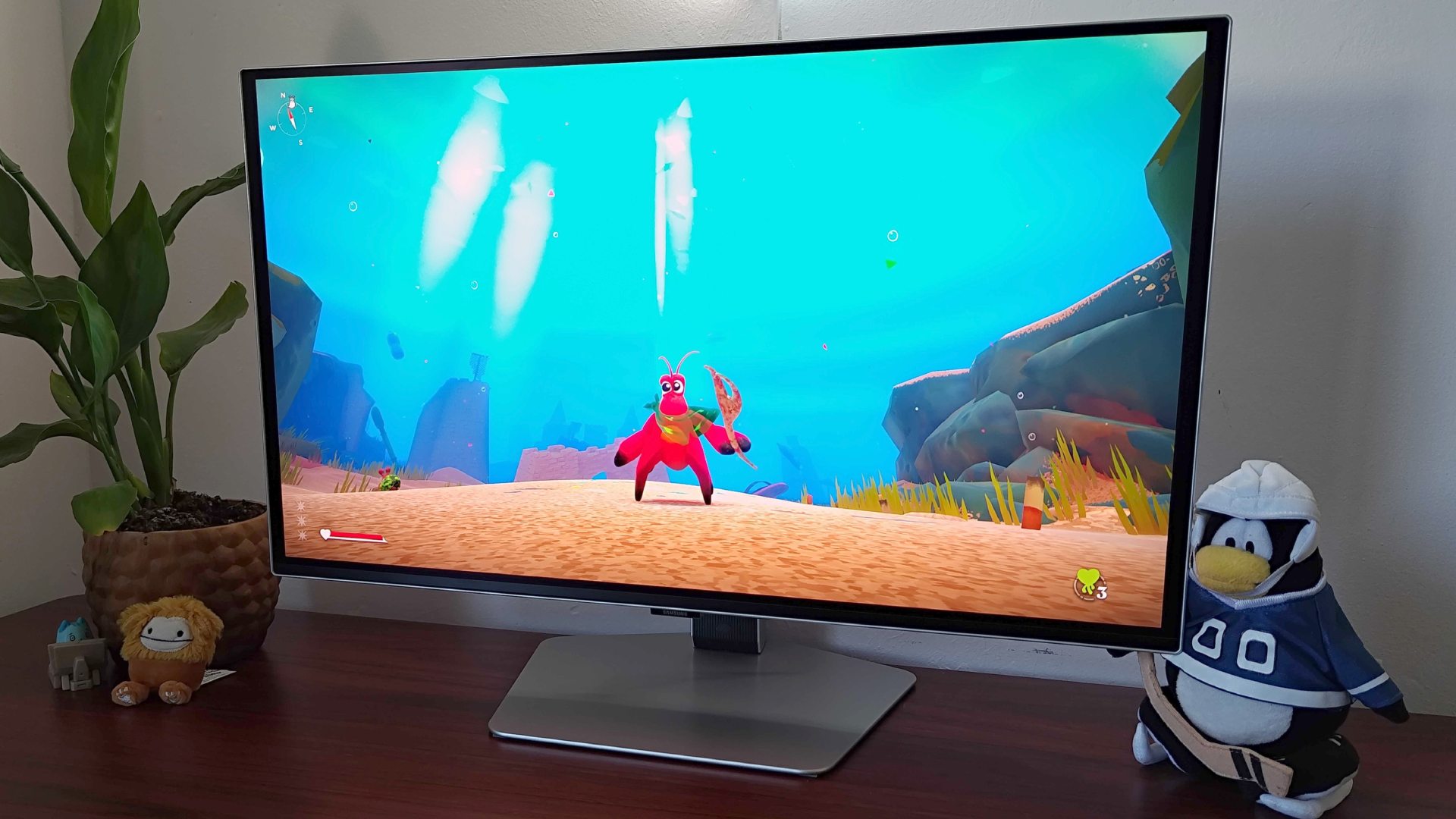
Speed and contrast should naturally be on the G6’s side since we’re talking about a 360Hz OLED panel, and I’m not remotely disappointed in the real-life results. Every game used to test Samsung’s colorful speedster felt vibrant and snappy, not to mention I couldn’t detect any softness at 1440p.
To kick things off, I decided to go back to Another Crab's Treasure, a vivid underwater roguelike that puts OLED screens to work. The experience was undoubtedly elevated thanks to the excellent colors and contrast produced, but everything felt a bit deeper compared to other similar panels I’ve tested, including my favorite KTC screen. Getting everything to pop that bit more with extra attention to darker areas really makes the difference in this scenario, and it’s proof that firmware can do a lot of heavy lifting.
I’m also still making my way through Still Wakes the Deep, so reviewing the G6 provided me with a reason to spend some time on the game’s ghastly oil rig. It’s easy to praise an OLED screen when displaying vibrant worlds, but I like to think how they deal with dingy environments makes more of an impact. And, for what it’s worth, Samsung’s screen does an admiral job of bringing The Chinese Room’s Scottish nightmare to life, with shadows maintaining a perfectly murky but detailed presence on screen.

On that note, I am delighted at the OLED G6’s HDR abilities, as I frequently have a bad time when using the feature. Rather than trading away brightness and vibrancy, this monitor enhances those darker scenes and adds excellent differentiation. Neon signs in the likes of Cyberpunk 2077 cut through the darkness of Night City to provide a genuine glow rather than a compromised effect, adding to the sense of realism already established by the OLED panel itself. The last time I was this impressed with HDR was when testing the new LG OLED G4, so it's nice to see screens reach the standard of the best gaming TVs out there.
It’d be criminal to ignore the G6’s 360Hz refresh rate, so I naturally was forced to enjoy a good few sessions of Halo Infinite. This isn’t my first rodeo with a monitor with this kind of speed, and I did feel a difference when using the Alienware AW2724HF last year. The difference here is that Samsung has avoided stooping to 1080p to provide extra responsiveness and pulling off a 50:9 KD ratio in Capture the Flag feels all the better when enjoying excellent map visuals.
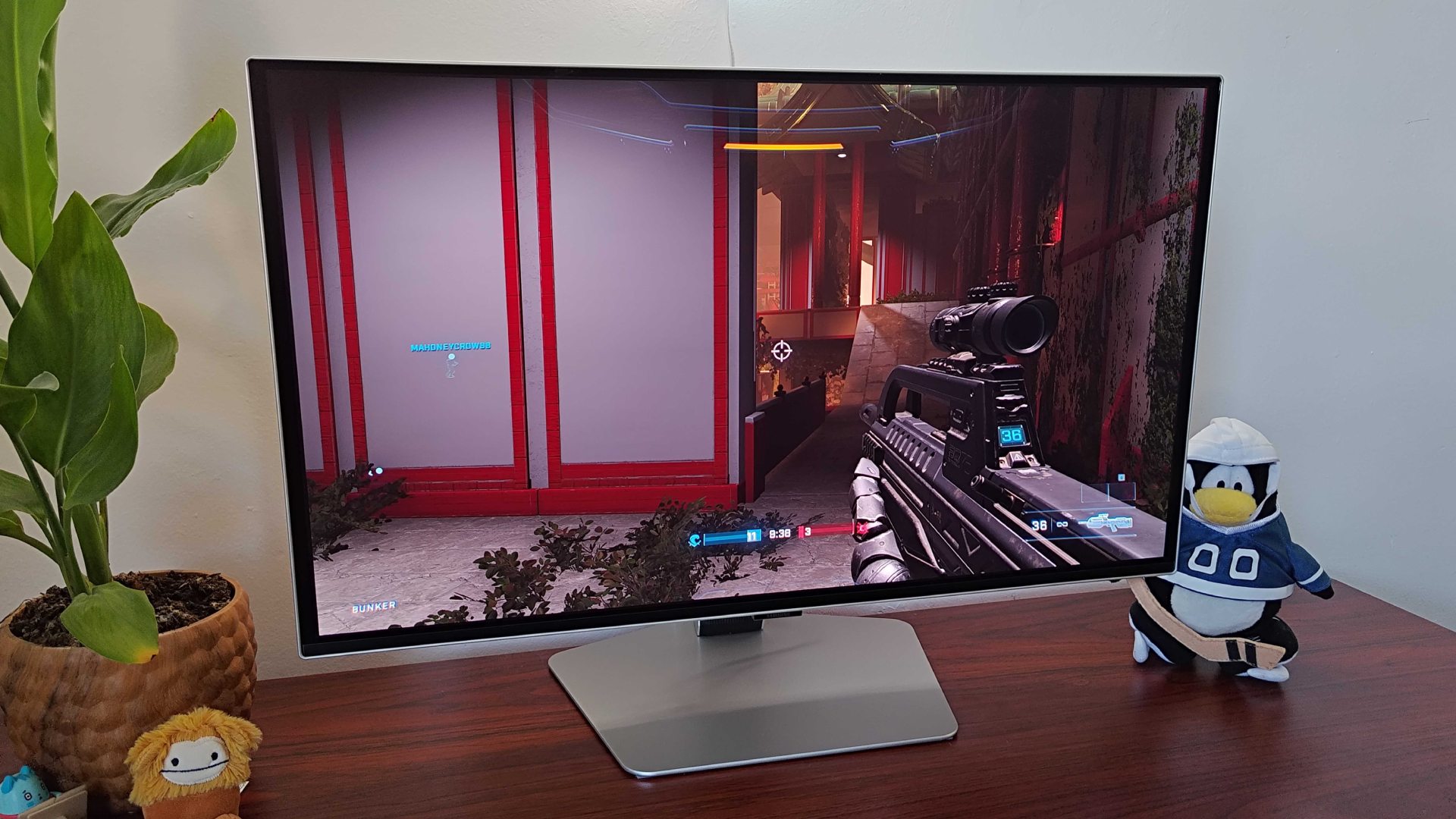
For real, though, I genuinely felt like I was at peak performance as a virtual Spartan using this monitor, and it even lured me back into messing around with Overwatch 2 matches. It’s worth stressing that you realistically need a beefy PC to feel the benefits of 360Hz without dialing everything down to boost fps. But, if you do happen to have an Nvidia GeForce RTX 4090 rig to hand, you’ll get to feel smug as you jetpack around as Pharah with pinpoint accuracy and responsiveness.
Outside of my usual tests, I’ve also been subjecting the G6 to my usual shenanigans. For anyone unacquainted, that ranges from chaotic Baldur’s Gate 3 sessions to hooking up an Xbox 360 using an upscaler mainly for the giggles, and the screen held up in every predicament I placed it in. My main worry was that I’d spot some softness compared to the 4K screens I normally use day-to-day, but I genuinely couldn’t really tell the difference at 1440p on this display. Keep in mind that sticking with 27 inches is likely the reason, but it’s still a point worth making in Samsung’s favor.
Should you buy the Samsung Odyssey G6?
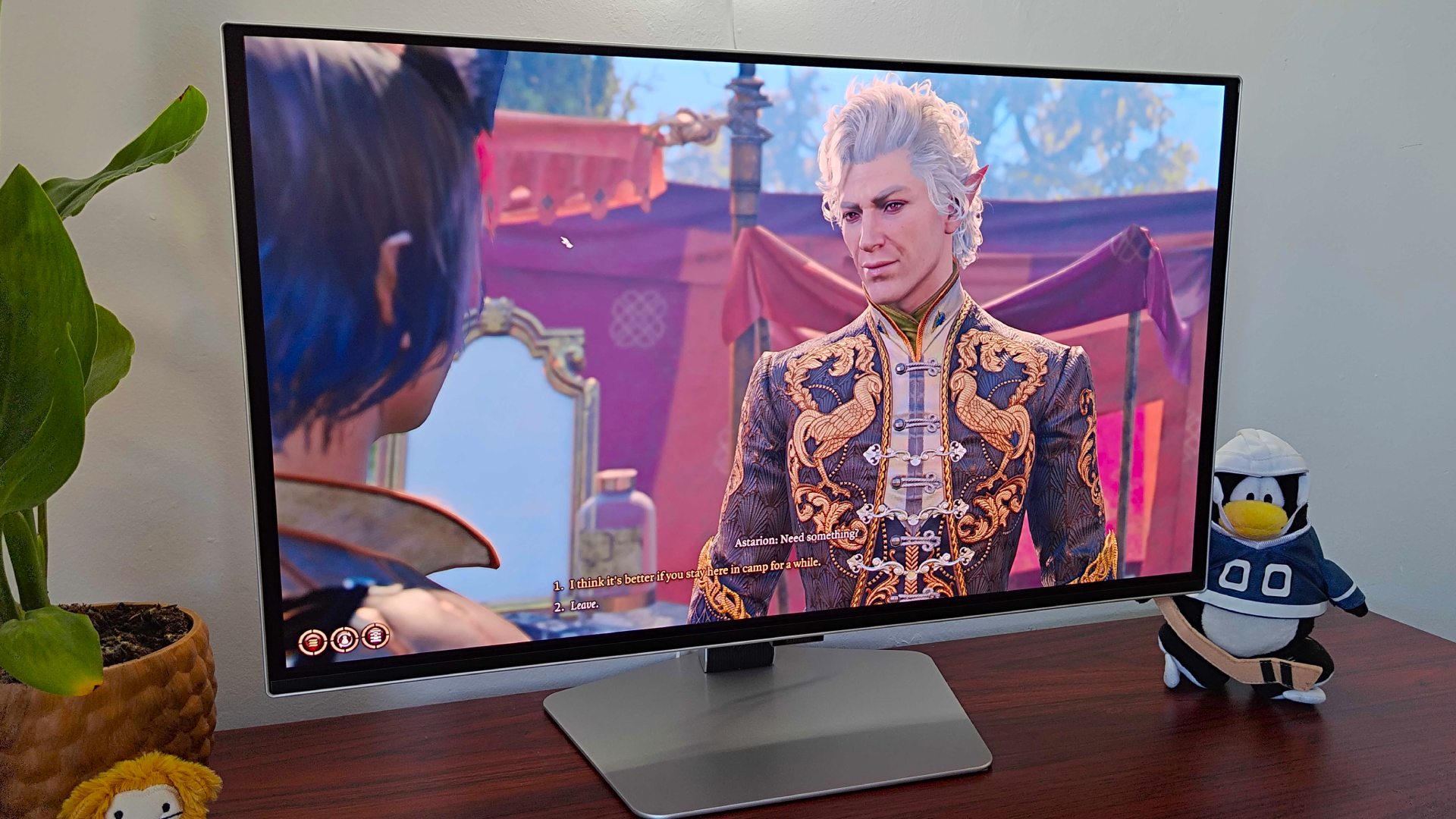
As far as OLED gaming monitors go, the Samsung Odyssey G6 is one of the punchiest panels out there. Raising the refresh rate bar from 240Hz to 360Hz is impressive enough, but this incredibly balanced screen also offers up fantastic HDR, incredibly useful anti-glare properties, and colors that cement why the tech is worth investing in over VA and IPS displays.
At 27 inches, I’d say the OLED G6 will still satiate even PC enthusiasts with its 1440p capabilities, as its smaller size keeps visuals from feeling soft. For those of you who really can’t stand the idea of not maxing out things at 4K, or if you’re looking for a UHD alternative for your PS5 and Xbox Series X, you’ll want to wait for my Samsung Odyssey G8 thoughts instead. Otherwise, I’d say this is the gaming monitor to buy right now if you’re looking for glorious gaming results for under $1,000.
How I tested the Samsung Odyssey G6
For a month, I used the Samsung Odyssey G6 to play several games using an RTX 4090 gaming PC. During that time, I assessed the screen’s capabilities when it comes to contrast, colors, HDR, and refresh rate alongside its included features and perks. To check responsiveness, I played several sessions of Halo Infinite and Overwatch 2 at 1440p and tweaked settings to match the panel’s 360Hz refresh rate with an appropriate frame rate, taking note of responsiveness compared to alternative 144Hz and 240Hz models.
I also leisurely played Still Wakes the Deep and Another Crab’s Treasure using the display to get a feel for the OLED G6’s brightness, contrast, and HDR results in different lighting scenarios, including during the daytime next to a large window.
For more information on how we test gaming monitors and other screens, check out our GamesRadar+ hardware policy to learn more.
Looking for more screens? Swing by the best monitor for PS5 and the best monitor for Xbox Series X for our console panel picks. Alternatively, take a peek at the best ultrawide monitors for a panoramic view.

I’ve been messing around with PCs, video game consoles, and tech since before I could speak. Don’t get me wrong, I kickstarted my relationship with technology by jamming a Hot Wheels double-decker bus into my parent’s VCR, but we all have to start somewhere. I even somehow managed to become a walking, talking buyer’s guide at my teenage supermarket job, which helped me accept my career fate. So, rather than try to realise my musician dreams, or see out my University degree, I started running my own retro pop culture site and writing about video games and tech for the likes of TechRadar, The Daily Star, and the BBC before eventually ending up with a job covering graphics card shenanigans at PCGamesN. Now, I’m your friendly neighbourhood Hardware Editor at GamesRadar, and it’s my job to make sure you can kick butt in all your favourite games using the best gaming hardware, whether you’re a sucker for handhelds like the Steam Deck and Nintendo Switch or a hardcore gaming PC enthusiast.
